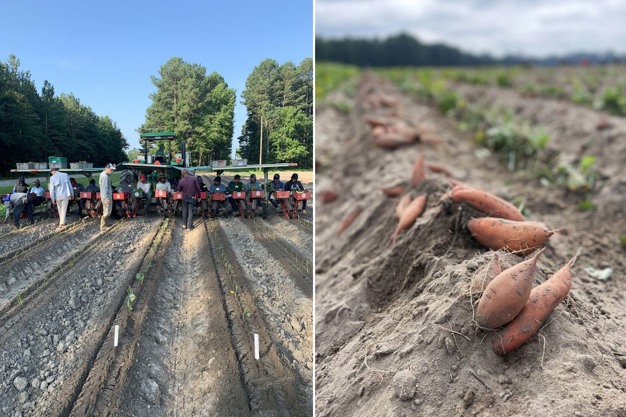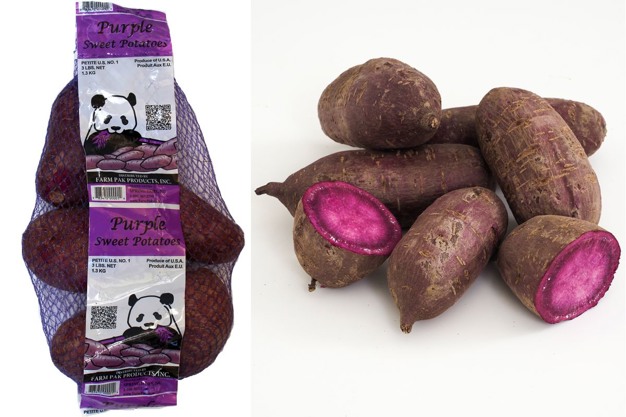Not many produce items make their way over from the United States to the European continent. However, sweet potatoes are an exception. Between 2007 and 2017, U.S. exports of sweet potatoes grew at a rapid pace, from 100 million pounds to a staggering 400+ million pounds annually. The majority made its way over to Europe and the high demand from overseas caused U.S growers to continue increasing their acreage. As a result, production went up from 1.3 billion pounds at the beginning of this century to 3.1 billion pounds in 2015. The U.S. sweet potato business was booming.
However, the situation took a turn in 2018 and exports started to decrease. The initial decline in exports was triggered by Hurricane Florence that caused significant damage to the North Carolina sweet potato crop in the fall of 2018. North Carolina is the largest sweet potato growing state in the nation and the impact on yields and production levels was significant. Low production levels caused export prices to increase, and it prompted large European importing countries like the United Kingdom and the Netherlands to replace U.S. imports with cheaper imports from lower cost producing countries like Egypt. This was the start of the U.S. losing market share to other exporting countries. U.S. exports continued to decline as more and more European countries started cultivating sweet potatoes themselves. What also didn't help the export market were a strong U.S. dollar and high sea freight rates. In addition, the EU imposed a temporary 25 percent tariff on U.S. sweet potatoes from November 2020 until March 2021. All the headwinds resulted in U.S. growers decreasing their acreage, further reducing total production levels.

How U.S. sweet potatoes differentiate
However, about six years after the first signs of falling U.S. sweet potato exports, it appears not to be so easy to grow a high-quality sweet potato product in Europe. Water availability and hesitation to invest in storage technology are limiting the growth in Portugal. Spain's production levels seem to be relatively stable and some other nations like France are growing for a niche market. Outside Europe, Egypt doesn't have the storage capabilities to supply sweet potatoes year-round. Does all of this offer new opportunities for the U.S.?
"We've been able to maintain our export levels in recent years and I strongly believe that is driven by the quality of our product," says Jacy Barnes Clapp with Farm Pak in North Carolina. "We've been educating our distributor-partners in Europe on the superior quality, taste, and shelf-life of our sweet potatoes. These are key differentiators that make customers come back to us for repeat purchases." Barnes Clapp adds that strong relationships with their customers have also helped in maintaining export levels. Another benefit for North Carolina is the relative proximity to the European continent. "Shipping from the U.S. East Coast to Europe is very reliable, something our customers appreciate."
Purple sweet potato variety
About 40 percent of Farm Pak's total production is exported and the main destinations include the U.K., the Netherlands, Germany, and Spain. Exports to these markets have been stable and in fact, there seems to be renewed interest for U.S. sweet potatoes because of a new purple variety that's available. "North Carolina has been known for the orange flesh variety Covington," commented Barnes Clapp. "It's the most sought-after sweet potato variety." However, purple sweet potatoes are increasing in popularity. "We've tried some purple varieties in the past, but North Carolina State University developed a new purple variety with a better taste profile." It's called Purple Splendor and was commercially harvested for the first time in 2023. The University has worked on the development of this variety for 15 years and since it is patented, farmers can purchase a license, allowing them to grow Purple Splendor.

Right: Purple Splendor. Photo credit: North Carolina State University.
Blue zones
Purple Splendor has been receiving a lot of attention this year, partly due to the Netflix documentary Live to 100: Secrets of the Blue Zones. In a few communities around the globe, people live long and healthy lives, up to and past 100 years of age. Residents of these blue zones share a common environment and lifestyle that scientists believe contribute to their longevity. Purple sweet potatoes are considered a key longevity staple for people in the Blue Zone of Okinawa. On this Japanese island, 70 percent of the population's diet is made up of purple sweet potatoes. Although Purple Splendor is a different variety from the variety consumed in Japan, the health benefits are the same and it has an even better taste profile.
The popularity of the Netflix documentary as well as people becoming increasingly aware of blue zones has resulted in a lot of interest for Purple Splendor, both domestically and in the European market. "We exported the variety for the first time this season and received a lot of interest from the U.K. in particular." Barfoots of Botley and Marks & Spencer heavily promoted Purple Splendor, proudly saying they are the only U.K. high street retailer to offer it.
Cost of labor
While this is a very promising development, the U.S. sweet potato industry isn't out of the woods just yet. One of the biggest concerns is the cost of labor. "In North Carolina, labor costs have doubled in the past five years and the Adverse Effect Wage Rate for foreign workers (H-2A) is $15.81/hour in 2024. However, once all other fees and expenses are factored in, the rate is well over $20 per hour," Barnes Clapp shared. Labor costs heavily weigh in the sweet potato industry as all harvesting in North Carolina is still done by hand. "Our production practices don't allow for mechanical harvesting as it could damage the skin." Nevertheless, Barnes Clapp is hopeful one day sweet potatoes can be harvested mechanically. "It would be great to have the best of both worlds." High labor costs are having a devastating impact. They have forced some growers to switch to other crops and some have gone out of business altogether. The industry just hasn't seen the price of sweet potatoes increase in the same way production costs have gone up.
 For more information:
For more information:
Jacy Barnes Clapp
Farm Pak
Tel: (+1) 252-459-3101
[email protected]
www.farmpak.com
